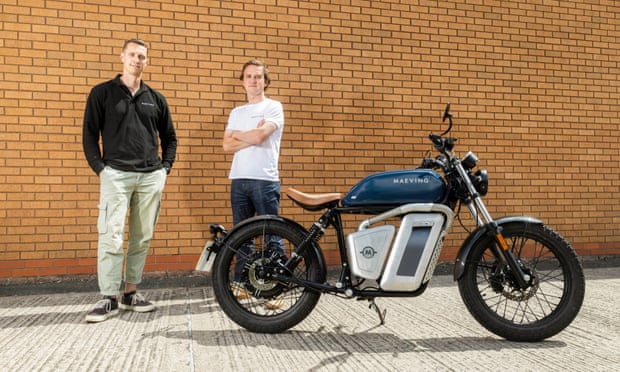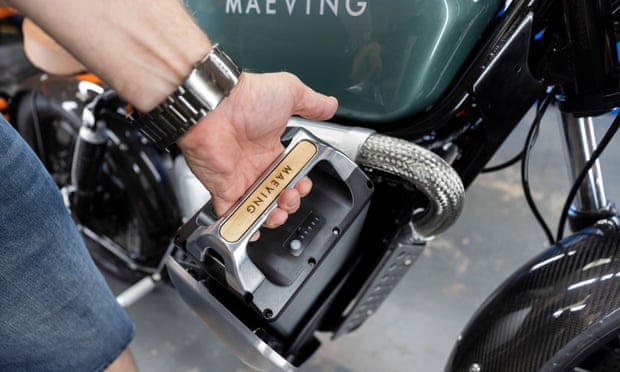EV riders: motorcycle manufacturers making the leap to electric
British startup Maeving is in the vanguard of a growing market worldwide for clean two-wheeled travel

The motorcycle industry has problems: its petrolhead riders are ageing, customer numbers are shrinking and bans on fossil-fuel power are looming.
Startup bike-maker Maeving thinks batteries are the answer to all three. Its RM1 motorbike swaps a noisy petrol engine for a near-silent electric motor and clean retro styling. During a test ride at the company’s factory near Coventry – by the Observer’s photographer – the experience is smooth, agile and gearless.
“Eco-conscious millennials” are a key market for the company. “Motorcycling has a massive problem with bringing in new riders,” says Will Stirrup, one of Maeving’s co-founders. “The holy grail for motorcycle manufacturers is bringing in young customers.”
The car industry is already reaching a tipping point in the move to batteries, but for motorbikes the challenge is trickier: it is more difficult to cram enough electrical energy into their small frames.
However, a growing number of companies are trying their luck. Harley-Davidson, the biggest US motorbike manufacturer, is offering the £29,000 LiveWire, with a 146-mile city riding range, and California-based Zero’s SR/S model starts at £20,100 for a 161-mile city range. At the other end of the scale is a host of Chinese manufacturers such as Super Soco, whose TSX starts at £2,900 for a 40-mile range. Another British startup, Arc, will deliver the first of its £90,000 Vector sports bikes in November.
Historic British marques are also trying to catch up: Norton said in June it was designing an electric machine; Triumph is at the prototype stage; and BSA, bought by Indian billionaire Anand Mahindra, plans to bring one out soon.
But there is a burgeoning – potentially bewildering – array of smaller options. Electrically assisted bicycles are already vying with electric push scooters (which are slowly on their way to legalisation in the UK) and electric mopeds.
Stirrup and co-founder Seb Inglis-Jones, 29 and 31 respectively, left careers in finance and marketing to found Maeving. They persuaded Graeme Gilbert, formerly head of product at Triumph, to lead on the design of the bike with the hope of getting ahead of established brands.
“The sluggishness of the major players did give us the opportunity,” says Stirrup, standing in the small factory where bikes are being assembled by hand. The team of 25 has delivered 100 machines so far, and they are hoping to produce 2,500 bikes a year – if they can get the funding.

Two 40-mile-range batteries, made by Samsung, can be charged at home and then slotted into compartments in the RM1 (which starts at £4,495 for a single-battery version). These power an in-wheel motor made by German automotive parts giant Bosch. The bike is limited to 45mph.
“We have completely, unashamedly designed this to be a great urban commuting vehicle,” says Inglis-Jones. “It’s just about making something that makes sense in context. Why don’t more people appreciate that motorcycling doesn’t have to be a niche sports activity?”
There is a tradeoff here: rapid charging – as for an electric car – is not possible, but the removable-battery model has real attractions for urban travel. Some Asian companies are well advanced in offering “battery as a service”, with a large network of swap stations. Bangkok’s Swap & Go, owned by Thailand’s state-owned oil company, and Taiwan’s Gogoro, which listed on New York’s Nasdaq in April, are two prominent examples. Swapping means that riders can “refuel” in less time than it takes to fill up with petrol.
The advantages of electric two-wheelers over petrol versions or cars in cities are clear: much less congestion, almost negligible air pollution and less noise. China already accounts for nearly half of all two-wheeler sales globally, and 70% of those are electric because of clean air rules, according to Patrick Hertzke at consultancy McKinsey’s London office. “Other large two-wheel and three-wheel markets, such as India, Indonesia, Thailand and Korea, are also primed for rapid growth,” he added, referring to widely used trikes such as tuk-tuks.
Tony Campbell, chief executive of the Motorcycle Industry Association, agrees that electric two-wheelers are coming in cities. But leisure motorbiking in rural locations will not really be possible on an electric bike until battery technology and charger availability improve, he says.
The UK government published a consultation last month suggesting that all mopeds, motorbikes and trikes must produce zero emissions by 2035. That has alarmed manufacturers which do not yet have batteries capable of like-for-like power replacement.
“Time will change this probably more quickly than manufacturers can appreciate,” Campbell says. “We just need more time.”